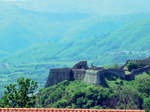Property in Garfagnana, Tuscany
Garfagnana offers better value than the more well-trodden areas of Tuscany, finds Carla Passino.


Hemmed in by the Apennines and the marble marvel of the Apuane Alps north of Lucca is Garfagnana, the other, wilder Tuscany. This is a land of silence, open vistas, soothing rain and poetry, where the valleys still ring with the verses of Ludovico Ariosto, Fulvio Testi and Giovanni Pascoli. In the past, the poetic quality of the Garfagnana landscape hid a grim life. Harsh soil and the vagaries of the weather made agriculture a daily struggle and, by the end of the 19th century, emigration to America and Scotland had become the only way to secure a better future. But many emigrants returned after forging their fortune abroad, and built elegant Art Nouveau villas with their newly made riches. And now that modernity has made life easier in Garfagnana the wild expanses of its parks lure growing numbers of Italian and foreign property buyers, and these villas are among the region's most sought-after homes.'Many people are interested in buying these properties, because they were built at the time when quality of materials and workmanship were in their prime,' says Michael Biagi of Tuscan Homes. 'They are like gold dust.' Benito Casci of Houses in Tuscany says that the market has expanded from the traditional request for a farmhouse with land to include small village houses, and Mr Biagi reports a particularly strong interest in 'new, semi-detached apartments because of their convenience'. Buyers, he explains, are 'lawyers, doctors and professional people' from Italy, as well as Germany, Scandinavia and, of course, Britain. One of the first and best-known faces to set up home in the area is East Lothian painter John Bellany now an honorary citizen of Fosciandora, the hamlet where he has a home whose vivid, colour-filled views of Garfagnana make for some of the region's most appealing 'advertisements'. Property remains more affordable here than in the rather more trodden 'Chiantishire'. 'Prices are stable because much of the incomers' demand is for homes such as houses in small villages which are not hugely popular among the locals, whereas the farmhouse with a vineyard is hard to find and more expensive,' says Mr Casci. He quotes ?75,000 to ?90,000 as the average budget required to buy a small village house of about 750sq ft to 860sq ft in need of some repair work. A detached house of about 1,000sq ft, set at the edge of a village, will cost about ?150,000 to ?200,000, and villas start from ?350,000. Of course, location makes a difference. 'The further up you go both in the sense of up the mountain (particularly above 2,300ft), and up to the north of the region, farther away from the cities the less property costs,' says Mr Casci. However, many remote villages have shops, and of those that don't, 'most have a bread van that comes in Monday to Saturday (you can order specialities from them, such as walnut bread), plus a grocery van once or twice a week,' says Francesca Casci of Houses in Tuscany. At the opposite end of the spectrum, prices are highest in Barga, a medieval hilltop town of red tiled roofs and grey stone houses where narrow streets ascend to a cathedral-crowned summit. 'But then, Barga is the hub of activity in the area,' explains Mr Biagi. 'It has a cinema, a theatre, shops and an opera festival.' 'Garfagnana is still excellent value for what you get a beautiful area, proximity to the airport and good roads,' says Mr Santi. But, perhaps most attractive of all, he adds, are the Garfagnini themselves. 'Garfagnana has a human dimension to it, a bit like certain parts of the north of England, where people tend to be friendly-nosy. It has still got heart.'
Exquisite houses, the beauty of Nature, and how to get the most from your life, straight to your inbox.
Country Life is unlike any other magazine: the only glossy weekly on the newsstand and the only magazine that has been guest-edited by His Majesty The King not once, but twice. It is a celebration of modern rural life and all its diverse joys and pleasures — that was first published in Queen Victoria's Diamond Jubilee year. Our eclectic mixture of witty and informative content — from the most up-to-date property news and commentary and a coveted glimpse inside some of the UK's best houses and gardens, to gardening, the arts and interior design, written by experts in their field — still cannot be found in print or online, anywhere else.
